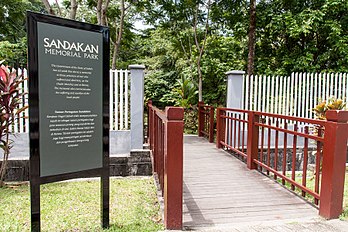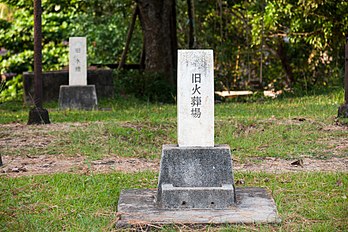Japanese occupation of British Borneo
Before the outbreak of World War II in the Pacific, the island of Borneo was divided into five territories. Four of the territories were in the north and under British control – Sarawak, Brunei, Labuan, an island, and British North Borneo; while the remainder, and bulk, of the island, was under the jurisdiction of the Dutch East Indies.
For the occupation in West Malaysia, see Japanese occupation of Malaya.
Japanese-occupied British Borneo (British North Borneo, Brunei, Labuan and Sarawak)North Borneo (北ボルネオ, Kita Boruneo)
Japanese (official)
Malay
Chinese
Bornean languages
Shōwa (Hirohito)
Masataka Yamawaki
7 December 1941
16 December 1941
1 April 1942
10 June 1945
15 August 1945
12 September 1945
1 April 1946
On 16 December 1941, Japanese forces landed at Miri, Sarawak having sailed from Cam Ranh Bay in French Indochina. On 1 January 1942, the Japanese navy landed unopposed in Labuan.[4] The next day, 2 January 1942, the Japanese landed at Mempakul on North Borneo territory. After negotiations as to the surrender of Jesselton with the Officers-in-charge of Jesselton and waiting for troop reinforcements, Jesselton was occupied by the Japanese on 8 January. However, it took the Japanese until the end of the month to conquer the entire territory of British Borneo. The Japanese subsequently renamed the northern part as North Borneo (北ボルネオ, Kita Boruneo), Labuan as Maida Island (前田島, Maeda-shima) and the neighbouring Dutch territories as South Borneo (南ボルネオ, Minami Boruneo).[5][6][7] For the first time in modern history all of Borneo was under a single rule.[8]
British Borneo was occupied by the Japanese for over three years. They actively promoted the Japanisation of the local population by requiring them to learn the Japanese language and customs. The Japanese divided North Borneo into five provincial administrations (shus) and constructed airfields. Several prisoner of war camps were operated by the Japanese. Allied soldiers and most colonial officials were detained in them, together with members of underground movements who opposed the Japanese occupation. Meanwhile, local Malay leaders were maintained in position with Japanese surveillance and many foreign workers were brought to the territory.
Towards the end of 1945, Australian commandos were deployed to the island by US submarines with the Allied Z Special Unit conducting intelligence operations and training thousands of indigenous people to fight the Japanese in guerrilla warfare in the Borneo Campaign in preparation for the arrival of the main Allied liberation missions. Following landings in North Borneo and Labuan on 10 June 1945 by a combination of Australian and American forces, the island of Borneo was liberated. The British Military Administration formally took over from the Japanese on 12 September 1945.
The Allies organised a liberation mission known as the Operation Oboe Six to reconquer the northern part of Borneo. This followed their success with Operations Oboe One and Oboe Two.[80][81] Under the cover of a naval and aerial bombardment, the 9th Australian Division landed on Borneo and Labuan on 10 June with a force of around 14,000 personnel.[81] With narrow roads and swampy conditions near the island beaches, the unloading operations by Royal Australian Engineers were hampered. Landings in the Brunei Bay area went more easily. The prediction of strong Japanese resistance proved inaccurate, with only few air raids against the Allied forces.[82]
The 24th Infantry Brigade, part of the 9th Division, landed at the southern end of Labuan, near the entrance of Brunei Bay, and commanding the approach to northern Borneo.[83] The 20th Infantry Brigade landed near Brooketon, on a small peninsula at the southern end of the bay.[83] The 20th Infantry Brigade rapidly secured Brunei Town against relatively light opposition, suffering only 40 casualties in the campaign. The 24th Infantry Brigade encountered stronger opposition in taking Labuan,[81] where the defenders withdrew to an inland stronghold and held out among dense jungle-covered ridges and muddy swamps. To subdue the Japanese resistance an intense naval and artillery bombardment was laid down over the course of a week before an assault was put in by two companies of infantry supported by tanks and flamethrowers.[83]
After securing Labuan, the 24th Infantry Brigade was landed on the northern shore of Brunei Bay on 16 June, while the 20th Infantry Brigade continued to consolidate the southern lodgement by advancing south-west along the coast towards Kuching.[84] The 2/32nd Battalion landed at Padas Bay and seized the town of Weston before sending out patrols towards Beaufort, 23 kilometres (14 mi) inland. The town was held by around 800–1,000 Japanese soldiers and on 27 June an attack was carried out by the 2/43rd Battalion.[84] Amid a torrential downpour and in difficult terrain, the 2/32nd Battalion secured the south bank of the Padas River. Meanwhile, one company from the 2/43rd was sent to take the town and another marched to the flanks, to take up ambush positions along the route that the Japanese were expected to withdraw along. The 2/28th Battalion secured the lines of communication north of the river.[85]
On the night of 27/28 June, the Japanese launched six counter-attacks. Amid appalling conditions, one Australian company became isolated and the next morning another was sent to attack the Japanese from the rear.[86] Fighting its way through numerous Japanese positions, the company killed at least 100 Japanese soldiers and one of its members, Private Tom Starcevich was later awarded the Victoria Cross for his efforts.[86] Following this, the Japanese withdrew from Beaufort and the Australians began a slow, cautious advance, using indirect fire to limit casualties. By 12 July they occupied Papar,[87] and from there sent out patrols to the north and along the river until the cessation of hostilities.[88] In August the fighting came to an end. The division's total casualties in the operation were 114 killed and 221 wounded, while the Japanese losses were at least 1,234.[84][89]
Aftermath[edit]
Japanese surrender[edit]
After the surrender of Japan on 15 August 1945 Lieutenant General Masao Baba, commander of Japanese forces in northern Borneo, surrendered at Layang-layang beach of Labuan on 9 September. He was then brought to the headquarters of Australian 9th Division, where at the official surrender ceremony on 10 September he signed the surrender document and handed over his sword to the divisional commander, Major General George Wootten.[90][91] The location became known as Surrender Point.[92]
It was estimated that around 29,500 Japanese remained on the island. 18,600 belonged to the IJA, 10,900 to the IJN.[93] The greatest concentrations of Japanese troops were in the interior.[94] There were some Japanese who refused to surrender and moved further inland. After calls from Lieutenant general Baba they also surrendered.[95] The Japanese repatriation following the surrender took several months, delayed due to lack of shipping. It was supervised by the Australians as Borneo along with New Guinea, Papua and the Solomon Islands were under their authority.[96] Australian forces also supervised the destruction of Japanese weapons and ammunition and the evacuation of internees and Allied POWs from Japanese camps.[97]
The British Military Administration (BMA) took over the task of management from the Australians on 12 September 1945 and summarised the situation towards the end of October:

















